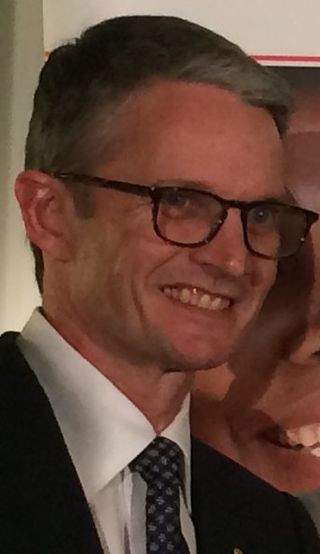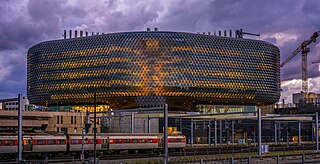The Canada Council for the Arts, commonly called the Canada Council, is a Crown corporation established in 1957 as an arts council of the Government of Canada. It is Canada's public arts funder, with a mandate to foster and promote the study and enjoyment of, and the production of works in, the arts.
The National Institute of Mental Health (NIMH) is one of 27 institutes and centers that make up the National Institutes of Health (NIH). The NIH, in turn, is an agency of the United States Department of Health and Human Services and is the primary agency of the United States government responsible for biomedical and health-related research.
The Royal Commission on the Future of Health Care in Canada, also known as the Romanow Report, is a committee study led by Roy Romanow on the future of health care in Canada. It was delivered in November 2002.
The Australian Research Council (ARC) is the primary non-medical research funding agency of the Australian Government, distributing more than A$800 million in grants each year. The Council was established by the Australian Research Council Act 2001, and provides competitive research funding to academics and researchers at Australian universities. Most health and medical research in Australia is funded by the more specialised National Health and Medical Research Council (NHMRC), which operates under a separate budget.

Research Councils UK, sometimes known as RCUK, was a non-departmental public body that coordinated science policy in the United Kingdom from 2002 to 2018. It was an umbrella organisation that coordinated the seven separate research councils that were responsible for funding and coordinating academic research for the arts, humanities, science and engineering. In 2018 Research Councils transitioned into UK Research and Innovation (UKRI).

The Australian Federal Police Association (AFPA) is a registered Industrial Organisation under the Fair Work Act 2009 operating as a Branch of the Police Federation of Australia. The AFPA has sole autonomous political and industrial coverage for all employees within the Australian Federal Police which includes sworn Federal Agents; Police Officers; Protective Service Officers; and non-sworn support staff deployed nationally and overseas. The Australian Federal Police Association also provides industrial coverage for the Australian Crime Commission and the Australian Commission for Law Enforcement Integrity.

On December 19, 2006, the Pandemic and All-Hazards Preparedness Act (PAHPA), Public Law No. 109-417, was signed into law by President George W. Bush. First introduced in the House by Rep. Mike Rogers (R-MI) and Rep. Anna Eshoo (D-CA), PAHPA had broad implications for the United States Department of Health and Human Services's (HHS) preparedness and response activities. Among other things, the act amended the Public Health Service Act to establish within the department a new Assistant Secretary for Preparedness and Response (ASPR); provided new authorities for a number of programs, including the advanced development and acquisitions of medical countermeasures; and called for the establishment of a quadrennial National Health Security Strategy.
The National Transport Commission (NTC), previously known as the National Road Transport Commission, is an Australian statutory body created to develop regulatory and operational reform for road, rail and intermodal transport.
The Australian Radiation Protection and Nuclear Safety Agency (ARPANSA) is a regulatory agency under the Commonwealth of Australia that aims to protect Australian citizens from both ionising and non-ionising radiation. ARPANSA works under the guidance of the Australian Radiation Protection and Nuclear Safety Act of 1998 as the national regulatory body of radiation in Australia, with independent departments within each state and territory that regulate radiation within each of their jurisdictions.
The Department of Social Security was a government department in Australia, which administered the Social Security system between 1972 and 1998. The department was one of several new departments established by the Whitlam government and was managed by the Minister for Social Security.

The Australian College of Optometry (ACO) is an Australian non-profit working to improve the eye health and well-being of various Australian communities. Established in 1940, the ACO's goal is to deliver public health optometry, vision research and professional education.

Brendan Scott CrabbFASM is an Australian microbiologist, research scientist and director and chief executive officer of the Burnet Institute, based in Melbourne, Victoria, Australia.

The Friends of Science In Medicine (FSM) is an Australian association which supports evidence-based medicine and strongly opposes the promotion and practice of unsubstantiated therapies that lack a scientifically plausible rationale. They accomplish this by publicly raising their concerns either through direct correspondence or through media outlets. FSM was established in December 2011 by Loretta Marron, John Dwyer, Alastair MacLennan, Rob Morrison and Marcello Costa, a group of Australian biomedical scientists and clinical academics.

The South Australian Health and Medical Research Institute (SAHMRI) is an independent health and medical research institute in Adelaide, South Australia. The institute is housed in a purpose-built eponymous building with its iconic "cheese-grater" design created by architects Woods Bagot, located in South Australia's health and biomedical precinct on North Terrace, just east of the Royal Adelaide Hospital.
David Joshua Handelsman, (AO) is trained in Medicine and Endocrinology. His expertise is in testicular function and androgen physiology, pharmacology, and toxicology. His experience spans basic, clinical, and public health domains including a recent focus on genetic models of androgen action, steroid mass spectrometry, and anti-doping science. He was Australia's first Professor in Reproductive Endocrinology and Andrology. He has worked in the US, Australia, and Germany. His professional involvement includes the World Health Organisation (WHO) Human Reproduction Programme's Male Task Force, WHO Human Reproduction Programme, United Nations Fund for Population Activities, Endocrine Society of Australia, World Anti-Doping Agency's Health, Medicine and Research Committee, and Australian Drug Evaluation Committee.
Janice Clare Reid is an Australian academic and medical anthropologist, who has specialised in Aboriginal and refugee health. She was Vice-Chancellor of the University of Western Sydney from 1998 to 2013.

Open access (OA) to academic publications has seen extensive growth in Australia since the first open access university repository was established in 2001 and OA is a fundamental part of the scholarly publishing and research landscape in Australia. There are open access policies at the two major research funders: The National Health and Medical Research Council (NHMRC) and Australian Research Council (ARC) and around half of Australian Universities have an OA policy or statement. Open Access Australasia, the Council of Australian University Librarians (CAUL), and the Australian Library and Information Association (ALIA) are advocates for Open Access and related issues in Australia.
Professor Anne Kelso is an Australian biomedical researcher specialising in immunology and influenza. She is the Chief Executive Officer of the Australian Government's National Health and Medical Research Council (NHMRC).

The Australian Health Protection Principal Committee (AHPPC) is the peak decision-making committee for public health emergency management and disease control in the Commonwealth of Australia. It is chaired by the Chief Medical Officer of the Australian Government and comprises the chief health officers of the states and territories.

Emily Banks is an Australian epidemiologist and public health physician, working mainly on chronic disease. She is a Professor of Epidemiology and Public Health and Head of the Centre for Public Health Data and Policy at the Australian National University, and a visiting professor at the University of Oxford.









